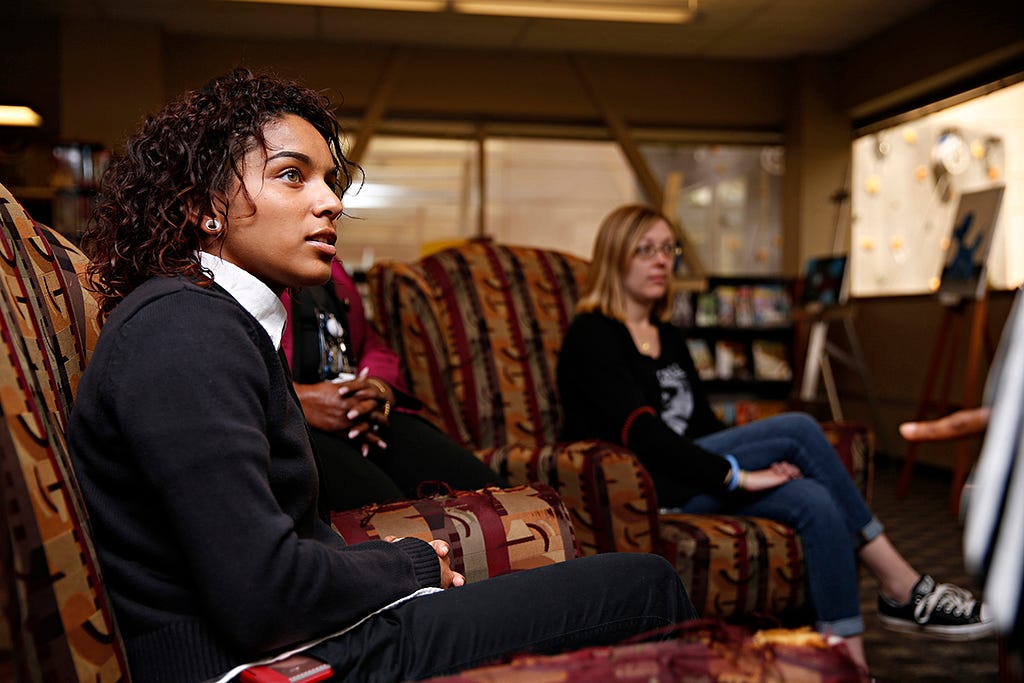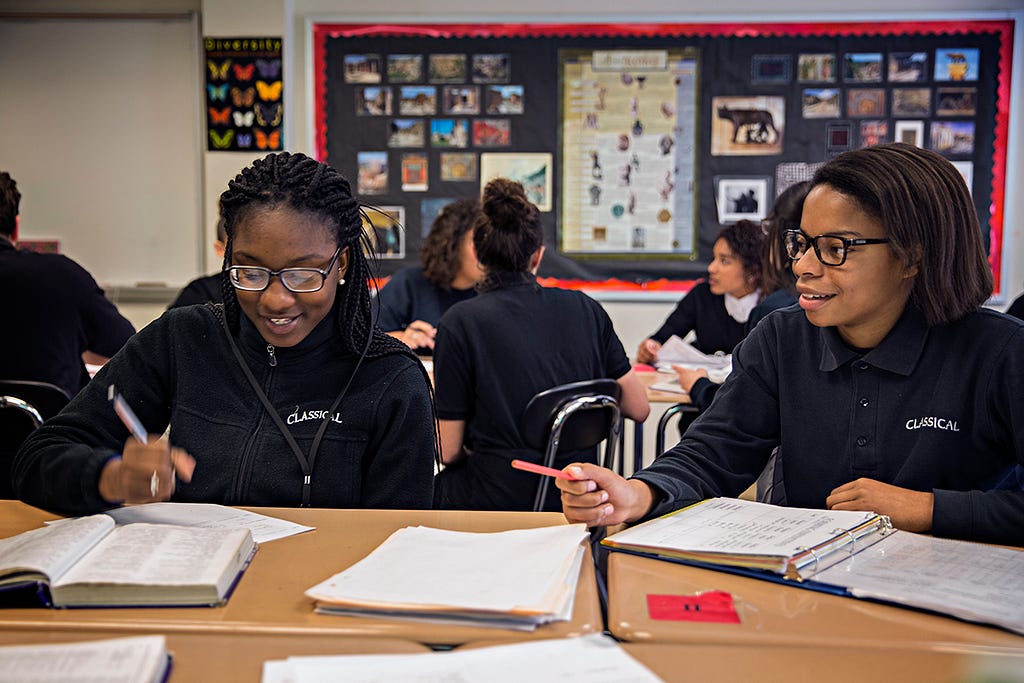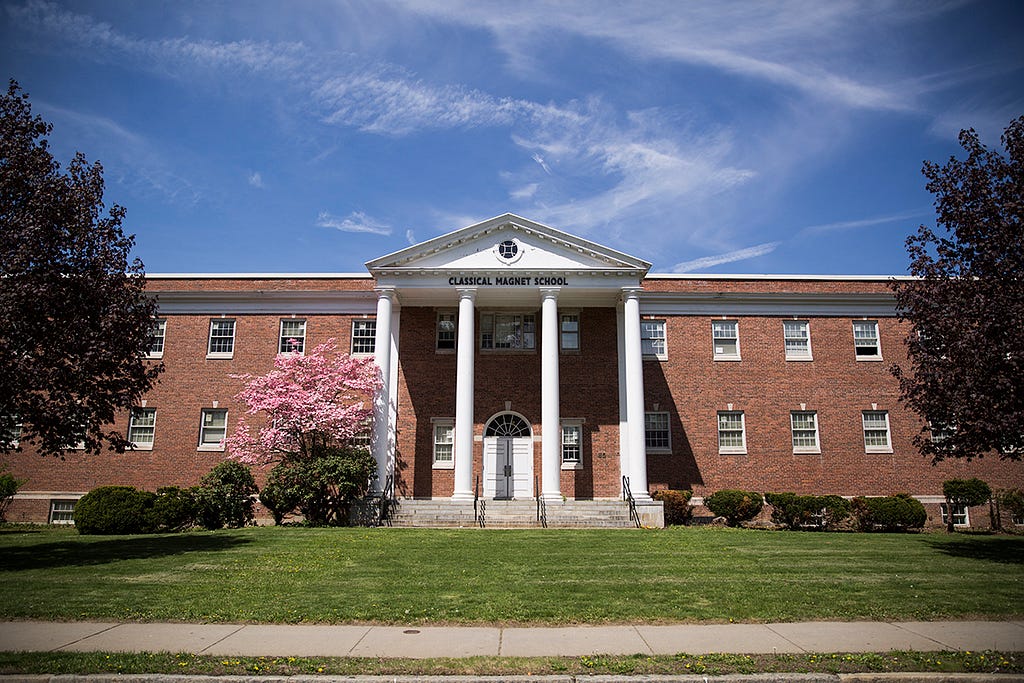School Segregation Can Be Fixed
More than 60 years after Brown v. Board of Education, integrated schools remain the exception not the rule. But with community support, the U.S. can create equal education for all.


Holly Weldon’s senior year at Classical Magnet School in Hartford, Conn., has been a busy one. In addition to playing on her varsity basketball and track teams, this 17-year-old created a local film festival for student filmmakers. In the fall, Holly will be headed to the University of Southern California in Los Angeles, and plans to study international business. While acknowledging that moving across the country to a sprawling city campus will be a big change, Holly exudes a been-there, done-that confidence that says she’s up for the challenge. She credits not just the academic rigor of her school, where every incoming sixth grader studies Latin, but the experience of having classmates from a variety of ethnic and economic backgrounds. “Being in a diverse school eases the transition of going from high school to college,” she says. “I know a lot of people that have grown up in a community where everybody looks like them and when they get to college it’s a giant culture shock. I’m not as worried because being in a magnet school educates us about how to get along with others and understand that while we’re different, we all share some type of common bond.”
More than 60 years have passed since the U.S. Supreme Court ruled that racially segregated schools were unconstitutional. Yet today, schools like Classical Magnet, where black, brown and white children are educated in the same building, are the exception, not the rule. Despite decades of research showing the academic and social benefits of integrated education, the nation’s schools are more segregated by race and income than they were in the late 1960s. The result is as predictable as it is devastating. “The average black and Latino student is in a school that is systematically unequal in every respect,” says UCLA professor Gary Orfield, co-author of a 2016 study of school segregation. “They have less prepared teachers, higher staff turnover, their curriculum is more limited, and their classmates are less prepared.” In the face of such vastly unequal opportunities, the differences in educational outcomes are staggering.
Nationwide, black and Latino students trail their white peers in academic proficiency by an average of 28 points in math and reading, a gap that school reform efforts have done little to close.
Education advocates explain the racial and economic isolation in the nation’s schools by citing federal court decisions beginning in the early 1990s that ended mandatory desegregation efforts, as well as the push for school choice. “Charter and school choice initiatives over the last 30 years,” Furman University education professor Paul Thomas says, “have increased segregation. It’s about the only thing you can say with certainty that they accomplish.” And Thomas harbors no illusions about why integration works; it ties the fate of students of color directly to that of white students. “A lot of people find it relatively offensive,” he says, “when we say that if we put black, brown and poor kids near some affluent white kids that will solve the [education] problem. It doesn’t solve the problem that we really don’t care about black, brown and poor kids.”
Current solutions proposed by education advocates to provide equitable education for low-income students of color are seemingly at odds with each other. Either black and brown kids can attend affluent schools outside of their local segregated communities, or neighborhood schools in high-poverty areas can provide extensive resources targeting the social and health needs of severely underserved communities. Both come with costs — financial or social — and to date there has been little sustained political will to implement either option on a national scale.
Hartford has been at the forefront of school desegregation efforts since a 1996 Connecticut Supreme Court ruling forced legislators to come up with a plan to reduce the severe racial and ethnic isolation of the city’s overwhelmingly black and Latino students. Urban flight that began as early as the 1950s saw white residents fleeing Hartford for the surrounding suburbs, taking well-paying jobs and a middle-class tax base with them. A walk through the area surrounding Classical Magnet highlights Hartford’s residential segregation. The overwhelming majority of white faces on the street belong to motorists on their morning commute, and the occasional white pedestrians are dressed in hospital scrubs, coming in and out of the vast network of medical facilities that dominate the aptly-named Asylum Hill neighborhood.
After years of negotiations following the court ruling, the program Connecticut has implemented is based on a voluntary desegregation model. It works by creating state-of-the-art urban magnet schools, including the one Holly attends, that offer AP classes, themed curriculums such as liberal arts or engineering, partnerships with local universities and internship programs with Hartford-based corporations. All of this is designed to entice white, suburban, middle-class families to forgo their local schools and instead place their children, and their self-interest, in Hartford’s public schools.

Getting white parents to even consider Hartford as an option has been a continuous struggle. Many fear that the program has simply run out of white families willing to send their children to schools, even high-performing ones, where children of color are the majority. Compounding this are demographic shifts that are making Hartford’s suburbs themselves less white. “We are having to reach deeper in the suburbs,” says Enid Rey, executive director of the Hartford Office of School Choice, which oversees the program. “This year we did something new. We rented a mall kiosk, the kind where you buy cell phone cases. We had teachers, principals and students talking to suburban moms as they walked by with their strollers.” Rey leaves no stone unturned when trying to recruit middle-class and affluent suburban families, because the magnet schools operate under a state-mandated quota: The black and Latino population must be no higher than 75 percent.
One of the ironies of a program created to improve educational opportunities for Hartford students of color is that the fewer white students a school enrolls, the fewer black and Latino students they can accept without falling out of compliance. Rey has seen the consequences of missing this target. “Schools can lose their magnet status,” she says. “We’ve had to de-magnetize two schools in the past two years because they really had no hope of compliance. One of them was a school with a phenomenal program.”
Even if a school remains open after this process, the loss of state funding can be devastating.
“The students are remunerated by the state at a significantly lower level after a school loses its magnet status,” says Rey. “And that has huge budget implications for the district. It’s a loss for all of our students.”

The urban magnet school program is one of two remedies created by Connecticut lawmakers to integrate schools. The second approach is for Hartford students to attend wealthier public schools in white suburban districts. But the voluntary nature of the program means that suburban school districts must opt-in, choosing to make seats available to Hartford’s black and Latino students. Few choose to participate. In 2015, while nearly 20,000 city and suburban students attended Hartford magnet schools, only 2,150 Hartford students had seats in suburban schools. When asked to explain such a striking disparity Rey is direct. “It’s racism,” she says. “When you’re not creating any sanctions for those communities to perpetuate their own isolation and whiteness, that’s problematic. Some communities have done a phenomenal job,” she notes. “But others simply will not take our kids.” Explaining that some suburban districts are facing declining enrollment numbers and that accepting Hartford students brings additional state funds, she says, “They’d rather close schools than offer those seats to Hartford families.”
In the face of widespread community resistance to school integration, educators nationwide are increasingly looking towards a full-service community school model in which the school serves as the hub of the underserved community in which it is located, combating the lack of resources in high-poverty neighborhoods by providing not just academic instruction but support services like accessible health care and family counseling.
Minnesota’s Brooklyn Center Secondary Arts and IB World, a 6th- through 12th-grade school located 10 miles north of downtown Minneapolis, is part of a district-wide community school program. School principal Cary Jarva explains that with 83 percent of her students qualifying for free or reduced lunch — meaning their families earn no more than 185 percent of the federal poverty level, or $24,600 for a family of four — many of her students are coming from backgrounds of generational poverty. Among the challenges this poses is parental involvement. “We have a systemic distrust…from the parents, families and guardians based on their own experiences in the educational system,” she says. “We spend a lot of time making sure that we’re in relationships with our students and we build meaningful relationships with our parents and families. It increases the chances of us being able to get an honest look at what’s needed.”
Brooklyn Center Secondary provides on-site medical care both for students in the building and those in the community, including screenings for sexually transmitted infections, reproductive management, dental and eye care, mental health counseling and therapists whom students can visit just by asking for a pass from their teacher. After Donald Trump was elected president, Jarva brought in an immigration attorney to speak with the school’s Latino families.
Students also have access to a range of extracurricular activities like math, science and debate teams, as well as mock trial and drama clubs.
One of those students is Molubah Seley, a 17-year-old senior who will attend Carleton College, a top 10-ranked private liberal arts institution in Minnesota, in the fall. He credits Brooklyn Center Secondary’s partnership with Get Ready, a college and career counseling program run by the Minnesota Office of Higher Education, with making it possible. “I’ve been using the Get Ready program since the 7th or 8th grade,” he says. “I’ve have some great mentors and role models to show me the way and ease some stress when it came to the college application process.”
There is not enough long-term data to determine whether community schools can be as effective at closing the achievement gap as integrated schools have been. The gap between black and white students shrank the most between 1970 and 1990, the peak years of school integration, and a study of 2011 national test scores showed that low-income fourth graders in wealthier schools performed two grade levels above their peers in high-poverty schools. While they are not designed to bring school integration into already-segregated neighborhoods, education experts do not see them as conflicting with school integration efforts. “There are communities where integration is exceptionally difficult,” says Kimberly Quick, a policy associate at the nonpartisan think tank The Century Foundation. “And in those cases, community schools are fantastic models to try and ensure that children and families have adequate resources where they are.” Quick and others, however, do have concerns about both scalability and sustainability. “Community schools are expensive,” Quick says. “Not only do they take community buy-in, they require funding. There might be will but you need resources.” And those resources invariably must come from outside the community in the form of private donations, taxes or a combination of both. The Brooklyn Center community school district dedicates more than 10 percent of its annual budget, almost $3.5 million dollars, to support services like health care and counseling, more than any single expense outside of academic instruction. The bulk of the district’s funding comes from the state, with local property tax revenue more than double that of federal government aid.
In order for community schools to flourish, Quick says, “We as a nation need to wrestle with what our role is in supporting children who are not our children. If you don’t want to fund a robust community school program, the other way to achieve equity is to invite [black, Latino, and poor children] into spaces they have previously been shut out of…affluent or middle-class schools. And it’s interesting to me how people can be against both of those things at the same time.”

Bright is made possible by funding from the Bill & Melinda Gates Foundation. Bright retains editorial independence. The Creative Commons license applies only to the text of this article. All rights are reserved in the images. If you’d like to reproduce this on your site for noncommercial purposes, please contact us. Follow us on Facebook and Twitter.
School Segregation Can Be Fixed was originally published in Bright on Medium, where people are continuing the conversation by highlighting and responding to this story.
Powered by WPeMatico


